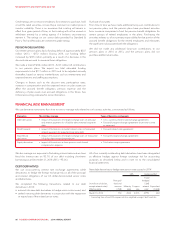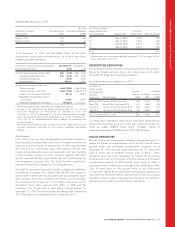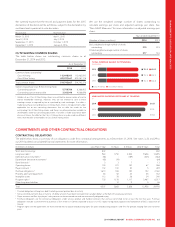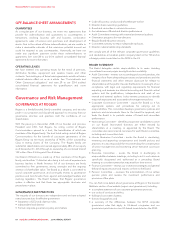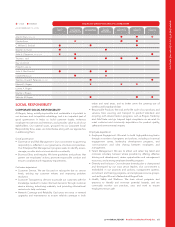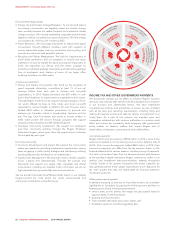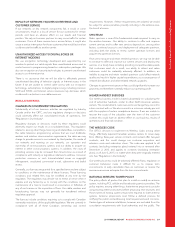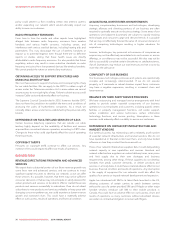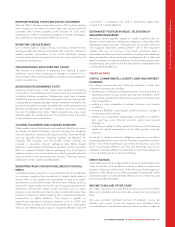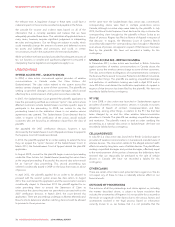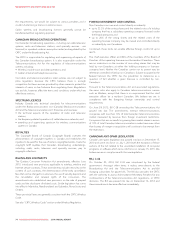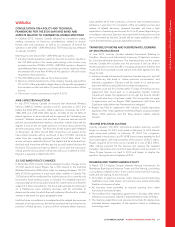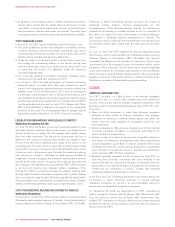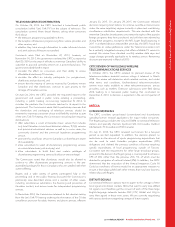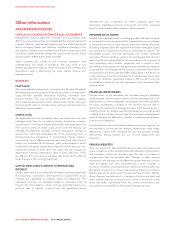Rogers 2014 Annual Report Download - page 74
Download and view the complete annual report
Please find page 74 of the 2014 Rogers annual report below. You can navigate through the pages in the report by either clicking on the pages listed below, or by using the keyword search tool below to find specific information within the annual report.MANAGEMENT’S DISCUSSION AND ANALYSIS
policy could prevent us from installing certain new antenna systems
and/or expanding our network which would ultimately impact our
ability to serve our customers.
RADIO FREQUENCY EMISSIONS
From time to time the media and other reports have highlighted
alleged links between radio frequency emissions from wireless
handsets and various health concerns, including cancer, and
interference with various medical devices, including hearing aids and
pacemakers. This may discourage the use of wireless handsets or
expose us to potential litigation even though there are no definitive
reports or studies stating that these health issues are directly
attributable to radio frequency emissions. It is also possible that future
regulatory actions may result in more restrictive standards on radio
frequency emissions from low-powered devices like wireless handsets.
We cannot predict the nature or extent of any restrictions.
OBTAINING ACCESS TO SUPPORT STRUCTURES AND
MUNICIPAL RIGHTS OF WAY
We must have access to support structures and municipal rights of way
for our cable facilities. We can apply to the CRTC to obtain a right of
access under the Telecommunications Act in areas where we cannot
secure access to municipal rights of way. Failure to obtain access could
increase Cable costs and adversely affect our business.
The Supreme Court of Canada ruled in 2003, however, that the CRTC
does not have the jurisdiction to establish the terms and conditions of
accessing the poles of hydroelectric companies. As a result, we
normally obtain access under terms established by the provincial utility
boards.
DEPENDENCE ON FACILITIES AND SERVICES OF ILECS
Certain business telephony operations that are outside our cable
territory highly depend on the availability of facilities and services
acquired from incumbent telecom operators, according to CRTC rules.
Changes to these rules could significantly affect the cost of operating
these businesses.
COPYRIGHT TARIFFS
Pressures on copyright tariffs continue to affect our services. Any
increase in fees could negatively affect our results of operations.
BUSINESS RISKS
REVENUE EXPECTATIONS FROM NEW AND ADVANCED
SERVICES
We expect that a substantial portion of our future revenue growth may
come from new and advanced services, and we continue to invest
significant capital resources to develop our networks so we can offer
these services. It is possible, however, that there may not be sufficient
consumer demand, or that we may not anticipate or satisfy demand for
certain products and services, or be able to offer or market these new
products and services successfully to subscribers. If we do not attract
subscribers to new products and services profitably or keep pace with
changing consumer preferences, we could experience slower revenue
growth and increased churn. This could have a materially adverse
effect on our business, results of operations and financial condition.
ACQUISITIONS, DIVESTITURES OR INVESTMENTS
Acquiring complementary businesses and technologies, developing
strategic alliances and divesting portions of our business are often
required to optimally execute our business strategy. Some areas of our
operations (and adjacent businesses) are subject to rapidly evolving
technologies and consumer usage and demand trends. It is possible
that we may not effectively forecast the value of consumer demand or
risk of competing technologies resulting in higher valuations for
acquisitions.
Services, technologies, key personnel or businesses of companies we
acquire may not be effectively assimilated into our business or service
offerings, or our alliances may not be successful. We also may not be
able to successfully complete certain divestitures on satisfactory terms,
if at all. Divestitures may reduce our total revenues and net income by
more than the sales price.
COMPLEXITY OF OUR BUSINESS
Our businesses, technologies, processes and systems are operationally
complex and increasingly interconnected. If we do not execute
properly, or if manmade or natural disasters impact them, customers
may have a negative experience, resulting in increased churn and
lower revenue.
RELIANCE ON THIRD PARTY SERVICE PROVIDERS
We have outsourcing and managed service arrangements with third
parties to provide certain essential components of our business
operations to our employees and customers, including payroll, certain
facilities or property management functions, call centre support,
certain installation and service technicians, certain information
technology functions, and invoice printing. Interruptions in these
services could adversely affect our ability to service our customers.
DEPENDENCE ON CERTAIN KEY INFRASTRUCTURE AND
HANDSET VENDORS
Our wireless business has relationships with a relatively small number
of essential network infrastructure and handset vendors. We do not
have operational or financial control over them, and only have limited
influence on how they conduct their business with us.
If one of our network infrastructure suppliers fails, it could delay adding
network capacity or new capabilities and services. Handsets and
network infrastructure suppliers can extend delivery times, raise prices
and limit supply due to their own shortages and business
requirements, among other things. If these suppliers do not develop
handsets that satisfy customer demands, or deliver products and
services on a timely basis, it could have a material adverse effect on our
business, financial condition and results of operations. Any interruption
in the supply of equipment for our networks could also affect the
quality of our service or impede network development and expansion.
Apple has introduced soft SIM to its latest iPads launched in the US,
allowing customers of certain carriers to switch between carriers
without the use of a carrier-provided SIM card. If Apple or other major
handset vendors introduce soft SIM to their mobile products in
Canada, this could have an adverse effect on our business, churn and
resultsofoperationsasmanycustomerswithoutsubsidizeddevices
are under no contractual obligation to remain with Rogers.
70 ROGERS COMMUNICATIONS INC. 2014 ANNUAL REPORT


